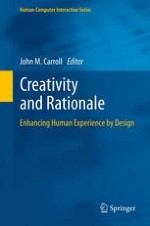2013 | OriginalPaper | Chapter
17. Mining Creativity Research to Inform Design Rationale in Open Source Communities
Authors : Winslow Burleson, Priyamvada Tripathi
Published in: Creativity and Rationale
Publisher: Springer London
Activate our intelligent search to find suitable subject content or patents.
Select sections of text to find matching patents with Artificial Intelligence. powered by
Select sections of text to find additional relevant content using AI-assisted search. powered by
